Royal Caribbean Group Bundle
How did Royal Caribbean Group become a cruise industry giant?
Embark on a journey through the captivating Royal Caribbean Group SWOT Analysis and the remarkable Royal Caribbean history. From its Norwegian roots in 1968 to its current status as a global leader, Royal Caribbean Group's evolution is a compelling story of innovation and strategic expansion. Witness how this cruise line industry titan redefined cruising, setting new standards for luxury and adventure on the high seas.
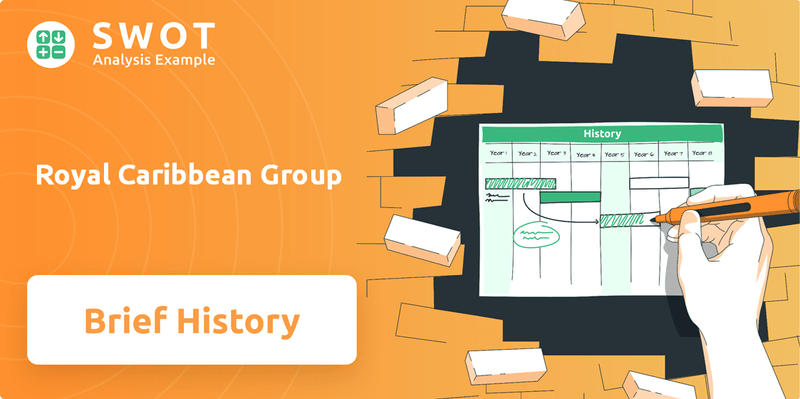
Understanding the Royal Caribbean company is crucial for anyone interested in the cruise ship history. The company's early cruise ships and pioneering spirit laid the foundation for its impressive growth. This exploration will delve into the key milestones, acquisitions, and innovations that have shaped Royal Caribbean Group into the powerhouse it is today, offering valuable insights into its enduring success.
What is the Royal Caribbean Group Founding Story?
The story of Royal Caribbean Group, a major player in the cruise line industry, began on June 7, 1968. It was founded by three Norwegian shipping companies: Anders Wilhelmsen & Co., Gotaas Larsen, and I.M. Skaugen & Co. This marked their entry into the passenger cruise business, capitalizing on the increasing popularity of leisure travel.
These companies saw an opportunity to offer Caribbean cruises, focusing on quality service and innovative ship design. The initial business model was built on providing premium vacation experiences. Their combined expertise in shipping and maritime operations laid a strong foundation for this new venture. The launch of their first ship, the Song of Norway, in 1970, was a key milestone.
The name, Royal Caribbean Cruise Line, was chosen to create a sense of luxury and exotic destinations. The founding companies provided the initial funding, leveraging their financial strength and industry connections. This collaborative effort aimed to tap into the growing American demand for vacation travel and the expanding cruise market. Learn more about the Growth Strategy of Royal Caribbean Group.
Royal Caribbean's initial focus was on Caribbean cruises, aiming for a premium experience.
- The founders were Norwegian shipping companies.
- The first ship was the Song of Norway, launched in 1970.
- The company's name reflected luxury and exotic destinations.
- Initial funding came from the founding companies' resources.
Royal Caribbean Group SWOT Analysis
- Complete SWOT Breakdown
- Fully Customizable
- Editable in Excel & Word
- Professional Formatting
- Investor-Ready Format
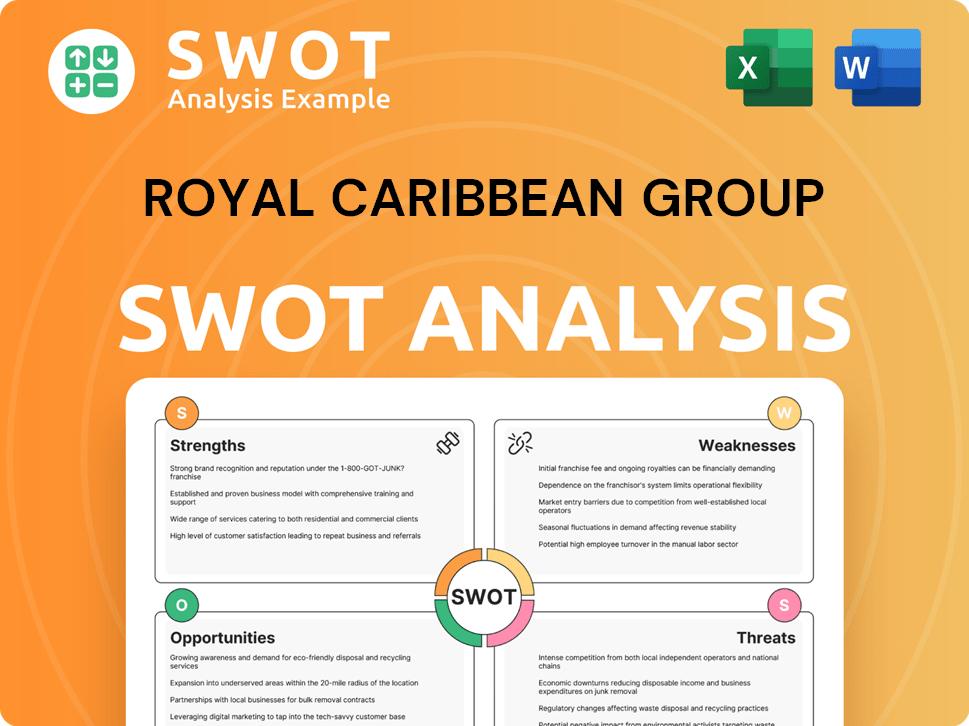
What Drove the Early Growth of Royal Caribbean Group?
The early growth of the Royal Caribbean Group, a pivotal moment in Royal Caribbean Group's history, centered on fleet expansion and a focus on the Caribbean. This strategic approach laid the foundation for its future success in the cruise line industry. The company's initial ships were designed to offer comfortable and engaging experiences, setting the stage for its brand reputation. This period also saw the company exploring new destinations within the Caribbean, expanding its reach.
Following the launch of the Song of Norway in 1970, the Royal Caribbean company introduced the Nordic Prince in 1971 and the Sun Viking in 1972. These early vessels established a consistent presence in the Caribbean market, offering passengers a taste of the cruise experience. These early ships were fundamental to building the brand's reputation for quality and service.
A significant turning point came in 1986 with the stretching of the Song of Norway, demonstrating the company's commitment to enhancing the guest experience. This innovative move increased passenger capacity and added new amenities. The company's focus on innovation helped it to stand out in the cruise ship history.
In 1988, Royal Caribbean introduced the Sovereign of the Seas, which was the largest cruise ship in the world at the time. This marked a pivotal moment in cruise ship history by introducing the 'mega-ship' concept with extensive onboard facilities. This innovation broadened the appeal of cruising, attracting a wider range of customers.
The company continued its expansion in the late 1980s and early 1990s with more Sovereign-class ships. By the mid-1990s, Royal Caribbean began expanding beyond the Caribbean, venturing into European and Alaskan itineraries. Leadership transitions during this period guided the company through these growth phases.
Royal Caribbean Group PESTLE Analysis
- Covers All 6 PESTLE Categories
- No Research Needed – Save Hours of Work
- Built by Experts, Trusted by Consultants
- Instant Download, Ready to Use
- 100% Editable, Fully Customizable
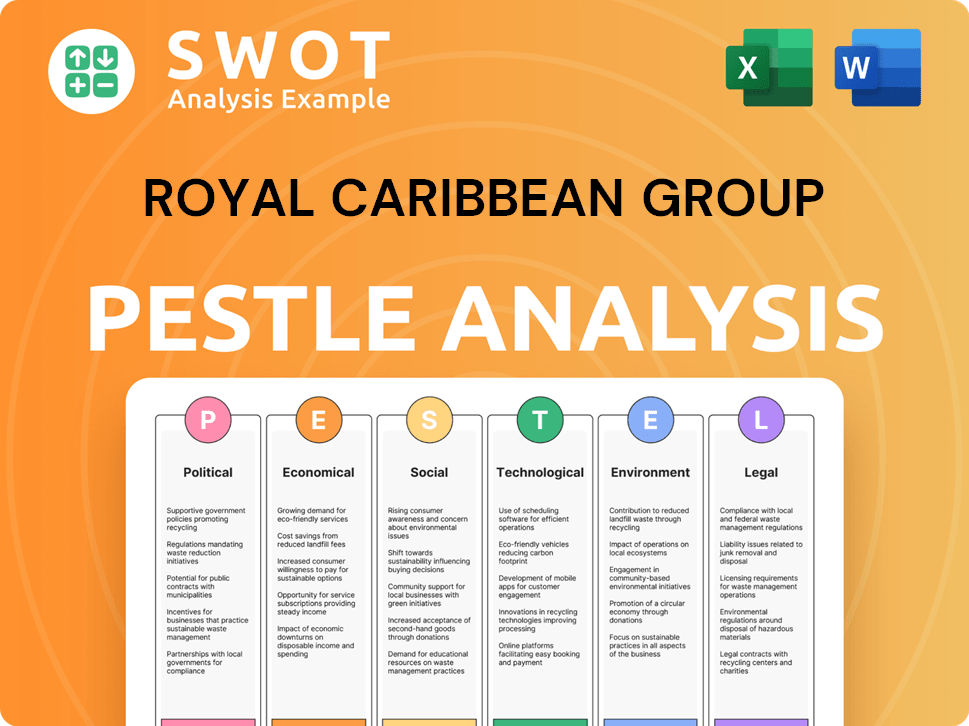
What are the key Milestones in Royal Caribbean Group history?
The Royal Caribbean Group has a rich Royal Caribbean history, marked by significant milestones that have shaped the cruise line industry. From its early beginnings to its current status as a global leader, the company's journey is characterized by innovation, strategic acquisitions, and responses to major challenges. The Royal Caribbean company has consistently expanded its fleet and offerings, setting new standards for the cruise experience and impacting the cruise ship history.
| Year | Milestone |
|---|---|
| 1968 | The company was founded as Royal Caribbean Cruise Line. |
| 1970 | The company's first cruise ship, Song of Norway, sets sail. |
| 1997 | Acquisition of Celebrity Cruises, expanding the company's market reach. |
| 1999 | Introduction of Voyager of the Seas, pioneering features like ice-skating rinks. |
| 2009 | Oasis of the Seas debuts, becoming one of the largest cruise ships with unique neighborhoods. |
| 2018 | Acquisition of Silversea Cruises, broadening the portfolio to include ultra-luxury cruises. |
The Royal Caribbean Group is known for its groundbreaking innovations in the cruise industry. These innovations include introducing features like ice-skating rinks, rock-climbing walls, and the Royal Promenade on its ships. The company also developed distinct 'neighborhoods' and a Central Park-like area on its Oasis-class ships, enhancing the onboard experience.
Voyager-class ships, starting with Voyager of the Seas in 1999, introduced features like ice-skating rinks and rock-climbing walls, redefining the cruise experience. These innovations set new industry standards for ship design and guest entertainment, attracting a broader range of customers.
Oasis-class ships, beginning with Oasis of the Seas in 2009, are among the largest cruise ships ever built and feature distinct 'neighborhoods' and a Central Park-like area. These ships offer a variety of experiences, appealing to diverse passenger preferences and enhancing the overall cruise experience.
The Royal Promenade, an interior street with shops and dining, was a pioneering feature introduced on Voyager-class ships. This design element created a vibrant social hub, enhancing the onboard experience and providing a variety of entertainment and dining options.
The AquaTheater, a unique entertainment venue, features high-diving and aquatic performances, adding a new dimension to onboard entertainment. This innovation provides guests with spectacular shows and enhances the overall cruise experience, setting Royal Caribbean apart.
The concept of distinct neighborhoods on Oasis-class ships offers diverse experiences within a single vessel, catering to various preferences. These neighborhoods include areas like Central Park and the Boardwalk, providing guests with a range of dining, entertainment, and relaxation options.
In response to the COVID-19 pandemic, the company launched the 'Healthy Sail Panel' initiative to establish and implement enhanced health and safety protocols. This initiative was crucial in facilitating a safe return to service and rebuilding passenger confidence.
The Royal Caribbean Group has faced several challenges, most notably the COVID-19 pandemic, which caused significant financial losses and operational disruptions. The company responded by implementing stringent health and safety protocols, including the 'Healthy Sail Panel' initiative. Economic downturns, such as the 2008 financial crisis, also impacted consumer spending on leisure travel, requiring strategic cost-cutting and itinerary adjustments.
The COVID-19 pandemic brought the cruise industry to a standstill, resulting in substantial financial losses and operational disruptions for the company. The company responded with the 'Healthy Sail Panel' initiative to implement stringent health and safety protocols, enabling a safe return to service.
The 2008 financial crisis impacted consumer spending on leisure travel, causing a decrease in demand for cruises. The company navigated this period through strategic cost-cutting, re-evaluating itineraries, and focusing on customer retention to maintain profitability.
Economic downturns have historically impacted the cruise industry, affecting consumer spending and demand for leisure travel. The company has adapted by implementing cost-saving measures, adjusting itineraries, and focusing on customer loyalty to mitigate the effects.
Various operational disruptions, including those caused by the pandemic, have presented challenges to the company's operations. The company has responded by implementing enhanced health and safety protocols and adapting its business model to ensure passenger safety and operational efficiency.
The company experienced financial setbacks, particularly during the pandemic, with significant decreases in revenue and net losses. Despite these challenges, the company has demonstrated resilience, adapting its strategies and leveraging its strong brand reputation.
Increased operational costs, including those related to health and safety measures, have presented financial challenges. The company has managed these costs through efficiency improvements and strategic pricing, while maintaining passenger safety and satisfaction.
The Royal Caribbean Group has shown strong recovery as of early 2025, with increased revenue and booking volumes, indicating a robust return to pre-pandemic levels. For a deeper dive into the company's financial performance and future prospects, you can read more about it in this comprehensive analysis of the Royal Caribbean Group timeline.
Royal Caribbean Group Business Model Canvas
- Complete 9-Block Business Model Canvas
- Effortlessly Communicate Your Business Strategy
- Investor-Ready BMC Format
- 100% Editable and Customizable
- Clear and Structured Layout
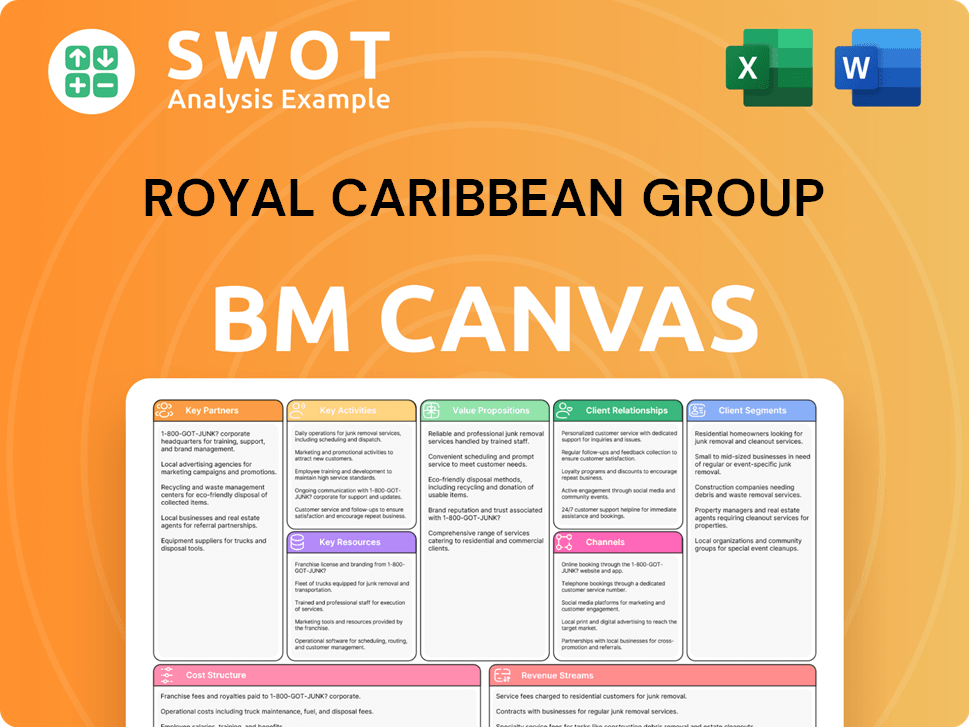
What is the Timeline of Key Events for Royal Caribbean Group?
The Royal Caribbean Group has a rich history marked by significant milestones and strategic expansions. From its humble beginnings in Norway to becoming a global leader in the cruise line industry, the company has consistently innovated and adapted to changing market dynamics. The Royal Caribbean history includes groundbreaking ship designs and strategic acquisitions that have shaped its trajectory and solidified its position in the cruise ship history.
| Year | Key Event |
|---|---|
| 1968 | Royal Caribbean Cruise Line is founded in Norway. |
| 1970 | The company launched its first ship, the Song of Norway. |
| 1988 | Introduction of the Sovereign of the Seas, the world's largest cruise ship at the time. |
| 1997 | Celebrity Cruises was acquired, expanding the company's market reach. |
| 1999 | Voyager of the Seas was launched, introducing innovative onboard features. |
| 2009 | Debut of the Oasis of the Seas, one of the largest cruise ships ever built. |
| 2018 | Silversea Cruises was acquired, entering the ultra-luxury cruise segment. |
| 2020-2021 | The COVID-19 pandemic caused a significant operational pause and financial impact. |
| 2022-2024 | Gradual return to service and strong financial recovery, with increased booking volumes and revenue. |
| 2024 | Royal Caribbean Group announced strong earnings and a positive outlook, with record bookings for 2025. |
| 2025 | Anticipated launch of new ships across its brands, continuing fleet modernization and capacity growth. |
Royal Caribbean Group is focused on sustainable growth by leveraging its strong brand portfolio and innovative ship designs. The company aims to expand its global footprint, especially in emerging markets. Strategic initiatives include investing in new ship classes that prioritize energy efficiency and environmental sustainability. This aligns with broader industry trends towards greener operations.
The company aims to enhance the guest experience through technological advancements and diverse itineraries. This includes optimizing its fleet and exploring new destinations. Leadership is committed to delivering exceptional vacation experiences while focusing on profitability and shareholder value. The company is adapting to meet the demands of a dynamic global travel market.
Analyst predictions for 2025 and beyond indicate continued growth in the cruise sector. Royal Caribbean Group is well-positioned to capitalize on this trend, given its strong booking trends and strategic investments. The company's financial recovery is evident with increased booking volumes and revenue. In 2024, the company announced strong earnings and a positive outlook.
Royal Caribbean Group continues to modernize its fleet and explore new destinations. The company is focused on catering to evolving consumer preferences, including the growing demand for experiential travel. This forward-looking approach remains true to the founding vision of offering innovative and high-quality cruise vacations. The company is committed to delivering exceptional vacation experiences.
Royal Caribbean Group Porter's Five Forces Analysis
- Covers All 5 Competitive Forces in Detail
- Structured for Consultants, Students, and Founders
- 100% Editable in Microsoft Word & Excel
- Instant Digital Download – Use Immediately
- Compatible with Mac & PC – Fully Unlocked
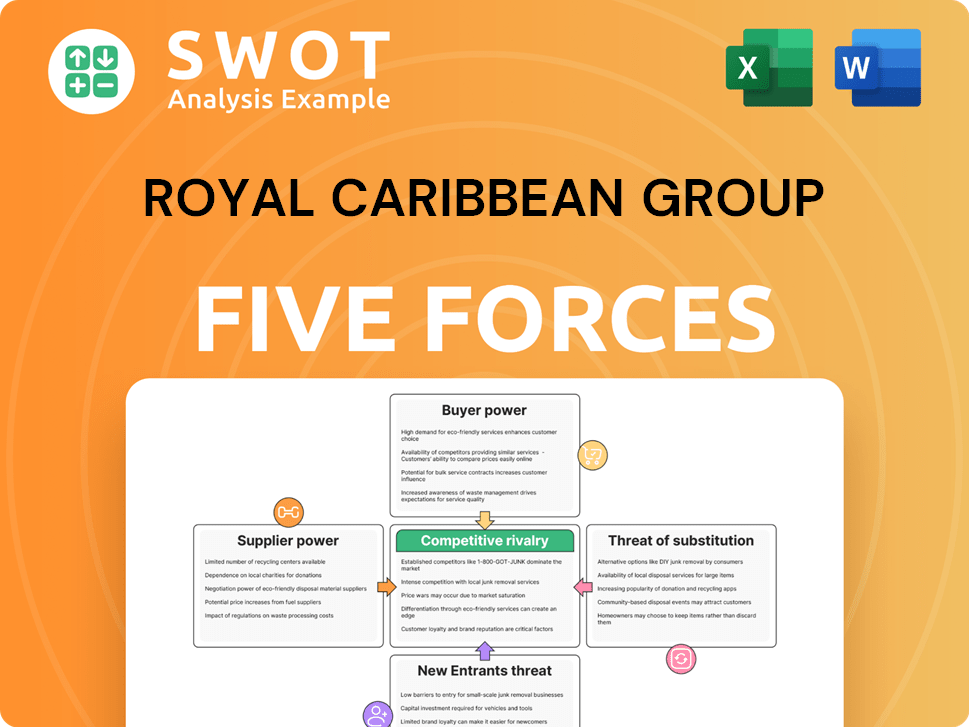
Related Blogs
- What is Competitive Landscape of Royal Caribbean Group Company?
- What is Growth Strategy and Future Prospects of Royal Caribbean Group Company?
- How Does Royal Caribbean Group Company Work?
- What is Sales and Marketing Strategy of Royal Caribbean Group Company?
- What is Brief History of Royal Caribbean Group Company?
- Who Owns Royal Caribbean Group Company?
- What is Customer Demographics and Target Market of Royal Caribbean Group Company?
Disclaimer
All information, articles, and product details provided on this website are for general informational and educational purposes only. We do not claim any ownership over, nor do we intend to infringe upon, any trademarks, copyrights, logos, brand names, or other intellectual property mentioned or depicted on this site. Such intellectual property remains the property of its respective owners, and any references here are made solely for identification or informational purposes, without implying any affiliation, endorsement, or partnership.
We make no representations or warranties, express or implied, regarding the accuracy, completeness, or suitability of any content or products presented. Nothing on this website should be construed as legal, tax, investment, financial, medical, or other professional advice. In addition, no part of this site—including articles or product references—constitutes a solicitation, recommendation, endorsement, advertisement, or offer to buy or sell any securities, franchises, or other financial instruments, particularly in jurisdictions where such activity would be unlawful.
All content is of a general nature and may not address the specific circumstances of any individual or entity. It is not a substitute for professional advice or services. Any actions you take based on the information provided here are strictly at your own risk. You accept full responsibility for any decisions or outcomes arising from your use of this website and agree to release us from any liability in connection with your use of, or reliance upon, the content or products found herein.